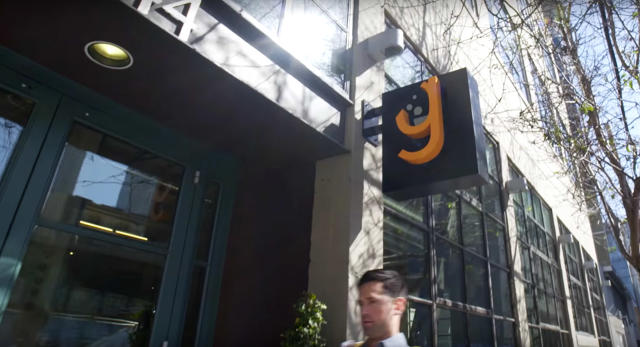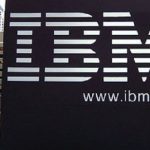Inside IBM’s New App-Building Training Ground
The space was a large, vacant, concrete-filled floor in a lower Manhattan office building. Plastic tarps covered many of the walls; wide columns held the building up; construction workers toiled away at various tasks. My guide pointed in the direction of a wall and said that a “public-facing” cafe would be there. The rest of the 50,000-plus square feet space would be generally open, a place for people to sit at a desk and work or talk with others about what they’re working on.
This was the site of IBM’s new Bluemix Garage in New York. While it officially opened last week, the current space is only temporary and on the floor below the construction zone. The real space won’t be ready to go for many months.
Bluemix can be most easily described as an IBM program for companies and developers to build and scale enterprise apps. The company bills it as a way customers can figure out how to build these applications, iterate on them, and then scale them. The focus is on offering tools and training that gets apps deployed fast. The garage is a space for IBM to evangelize its method.
In many ways Bluemix Garages look like a coworking space inside a startup accelerator. IBM partners with startups to host the space—in the case of the new Manhattan garage, the tech-skill focused education company Galvanize is the selected partner. The space is predominately Galvanize’s, but Bluemix has dedicated areas for developers working with the program. The first garage opened in San Francisco in 2014, and now there are seven locations globally.
The “Method”
IBM VP of cloud technology Angel Luis Diaz proselytizes Bluemix much like a thought leader giving a TED talk. He uses words like “iteration” and “methodology” to describe Bluemix’s impact. The whole concept, he says, is to work with companies and “bring them into the ideation process.” These organizations turn to this process with an idea to build an app, then use the “prescriptive approach” to make it a reality over the course of weeks. He’s been building this pedagogy for over five years—it was “born through us learning,” Diaz says. He adds that all people can be part of the process—be they designers, developers, or executives. The Bluemix program is supposedly a way to bring together these voices to help build products that can then be used more quickly. While there’s dedicated workspace for developers to build, Bluemix offers teams training and support with its “method” so they can figure out what apps they’re building and how to do that.
Beyond being a methodology, Bluemix is a way for IBM to look agile. It’s one of the many ways the behemoth century-old company is trying to appear more approachable, akin to dozens of other Silicon Valley entities. Indeed, the very construction of the Garage is meant to breed this type of startup ethos. The entrance will have a cafe that will be open to the public. Inside will be couches, open work stations, and the startup standard ping-pong tables. When I arrived at the space a little before 11 a.m. on a Wednesday morning, Diaz asked if I wanted a beer (I’m pretty sure he was kidding).

All the same, developers have been taking to the methodology, says Diaz. Every week 20,000 developers begin working with Bluemix and 112,000 new apps are produced every month. The idea behind the entire program, he impresses, is for companies to quickly build these applications and then “learn to scale to the enterprise.” It’s IBM’s business-app training ground. Diaz is sure to repeat that the method is “open source,” so anyone trying to build and scale an app for the enterprise can find the Bluemix materials online. The sell for big companies is that it allows them to quickly build programs that can be deployed across an entire network very quickly. One example IBM brings up is Kimberly Clark, which used Bluemix to build a series of apps that remotely monitor restroom supplies, such as soap dispensers and air fresheners.
The New York Program
While the New York garage is similar to the others IBM has in cities like Toronto, San Francisco, and London, IBM is specifically making an open pitch to blockchain developers. Blockchain is a technology made famous by bitcoin, which has a public digital ledger for every transaction performed that can be shared among a distributed network. Many companies are tinkering with blockchain because it could change the way digital transactions are performed. IBM says this is because it sees an increased need for training and leadership when it comes to this burgeoning technology. Financial services—along with multiple other industries—are trying to figure out ways they can use this new system (which was introduced to the world thanks to bitcoin), and implement it into their system. Many New York-based companies are trying to figure out what they can do. While there’s a blockchain focus in the New York garage, the space isn’t exclusively for that technology.

IBM’s program director of its blockchain offerings, Eileen Lowry, walked me through how the company is training people to use the technology. While few actual apps have been launched on public blockchains, IBM has been giving people access to private networks so they can build and test products. Right now, IBM’s platform is allowing developers to build “an industry type of sample application so that we can make it real for businesses,” she says. The plan is to have live apps up and running in the next few months. IBM says the company is already working with many financial institutions on various blockchain programs, including Mizuho Financial Group, Credit Mutuel Arkea, and the London Stock Exchange.
One of the real pluses Lowry sees blockchain doing is “providing visibility” for supply chains. That is, if one entity is paying another entity for goods to be sent and there’s a dispute over whether or not a transaction was completed correctly, blockchain’s digital ledger (which is theoretically tamper-proof) makes it possible to digitize the entire process. When party A pays party B, that transaction is recorded on the blockchain. When the goods are sent, that is also recorded. The same thing when they’re received. If there’s a dispute, it’s clear where the breakdown occurred. So, companies trying to create solutions to fix this problem could come to Bluemix and begin tinkering with new app possibilities.
But the Bluemix garage isn’t a blockchain training center, of course. It’s an open space where IBM can evangelize its way to lead, build, and scale apps. Despite the bombast, Bluemix isn’t some revolutionary program either—it’s the way that a big company positions itself to reel in businesses to use its services to build apps that scale efficiently. Pivotal Cloud Foundry, for example, offers very similar services. The garages seem to be ways for the company to present itself as more enticing. Sure, developers can receive free tools, trainings, and methodologies to build apps, but now they can go to a physical space and talk with other people and even get some free beer and ping-pong.
And for companies like IBM these sorts of offerings are important optics-wise. In a tech world that’s constantly changing and companies—no matter the size—trying to look hip and agile and startup-y, Bluemix is a way for IBM to look welcoming to the developer community. More importantly, it’s also a way for the company to sell cloud services to app makers and businesses.
When the official space opens in a few months, New York will be able to see it in action. If they want to build apps, they will definitely be able to do that. And if they just want coffee, they’ll get that too.
Related Video: Coding Lessons And Hackathons To Create A New Generation Of More Diverse Tech Company Employees
Fast Company , Read Full Story
(44)













